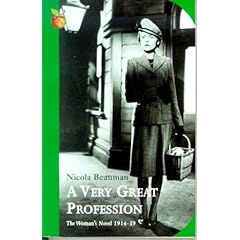
I’m halfway through Nicola Beauman’s A Very Great Profession: The Woman’s Novel 1914-39, which I found at the Persephone Books web site. Needless to say, this is just my kind of thing, a chatty, informative social history of women’s literature, much of which is out-of-print and has languished forgotten in library vaults. Pointedly yet gently, learnedly yet subtly, Beauman explains exactly why middle-class women loved these interwar women’s novels.
Middle-class women read novels, she tells us. Thank God. I’ve always considered the novel a necessary art form, and finally someone is telling me it’s fine to read them. Much of my youth was spent reading canonical poetry, novels, and history, but in recent years I've branched out to more obscure novels. Not all of them are by women. I also adore Patrick Hamilton’s The Slaves of Solitude, a Barbara Pymish novel with a bite, in which the spinster heroine lives in a rooming house to escape the blitz but must survive residents' fracases which disconcertingly mirror the politics of WWII. Nicola Beauman would love this book, if she hasn’t already gotten to it.
Among Beauman's favorites is Cicely Hamilton’s William-an Englishman, which was out-of-print when she wrote her book, but has since been reissued by Persephone. But some of them are simply impossible to find: I'd like Amber Reeves’s A Lady and Her Husband for my teapot collection (the husband runs tea shoppes). Yes, I collect books about tea--Tea at Four-Oclock by Janet O’Neill, Monica Dickens’s My Turn to Make the Tea, a tea shop mystery, etc.--but sadly Reeves’ book doesn’t seem to be around.
In a scene in the movie Brief Encounter, the heroine, Laura Jesson, goes into town to “change her library book.” Beauman wanted to know what the library book was. (I also have this obsession. Which Dickens book does Desmond keep in a plastic bag in LOST?.) When she saw it was a Kate O’Brien, she immediately wanted to write A Great Profession (though she was discouraged by one of her professors at Cambridge).
Beauman describes the British library system of the '20s and '30s. Circulating (rental) libraries were an important part of middle-class life, and Boots was the largest and most accessible of a chain of 400 branches in the 1930s.
"The Boots First Literary Course for librarians divided literature into categories, presumably so that the harassed attendant could at least decide which type of book her customer would find acceptable. One of the most popular (along with the detective and the love story) was Light Romance. The course lecturer said: ‘We often hear [women] say they like a “pretty” book. I am sure that your own taste in reading has developed far above this level, but to a librarian books are but tools and it is our duty to supply them to our subscribers without questioning their taste.’ He lent rather more of his approval to Family Stories, defined as being ‘for those tired of romance’ who are often seeking something with reality in it; the subscriber may define these as a ‘well-written book.’
Beauman categorizes the novels in a manner that is quite un-librarian-like: War, Surplus Women, Feminism, Domesticity, Sex, etc.. And as she documents the history, she speaks of many “middle-class women’s writers,” among them some of my favorites, Woolf, May Sinclair, Elizabeth Bowen, Enid Bagnold, an E. M. Forster.
This is a book I’ll treasure. Her appreciation of women's novels is like learning history effortlessly at the same time as getting recommendations from a literary friend.
No comments:
Post a Comment